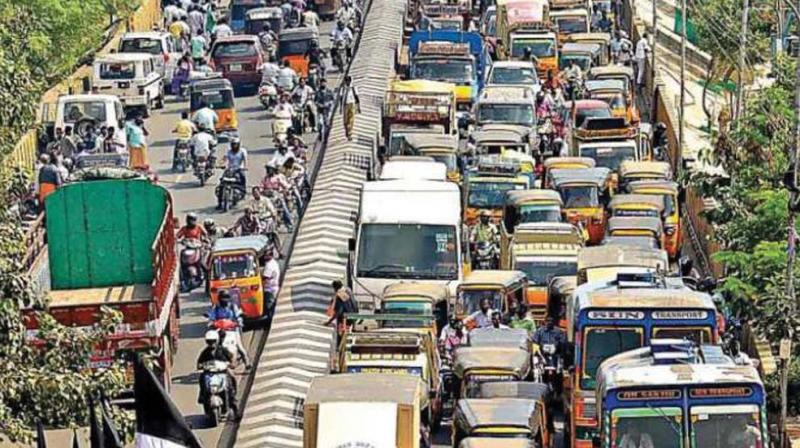Go public: Only buses, metro can bypass our gridlocks

Over 72 lakh vehicles, with over 1,500 new ones entering the streets everyday: It's no surprise that Bengaluru is the city of traffic jams. Urban planning seems geared towards making life easy for cars and efforts to improve public transport are woefully inadequate. Without end-to-end connectivity, a shortage of buses, limited Metro coverage, no headway made towards suburban rail and free parking space, private transport seems to be the obvious choice. Flyovers and signal-free corridors, the authorities’ default solutions, are palliative, at best. It’s time Bengaluru takes stock of its situation, reports Nikhil Gangadhar
As Bengaluru continues to struggle with its traffic, the government has come up with yet another solution : a Rs 15,825 crore, 95- km long elevated corridor. Announced by Chief Minister H D Kumarasway when presenting the state budget, the project involves building six inter-connected elevated corridors over the next four years in the city.
Besides connecting heavily congested areas like Hebbal to the Central Silk Board junction and KR Puram to Goraguntepalya, the project will also have smaller corridors connecting Minerva Circle, the NICE Road junction, Varthur Kodi and Richmond Circle.
If the government had expected applause for its new commitment to reducing traffic on the city’s roads, it has been sorely disappointed as several transport experts believe that another flyover, elevated corridor or underpass will make no difference to the traffic in the city where vehicles are increasing at an alarming rate on its roads.
A recent report titled “Level of service and sustainability analysis of the proposed elevated road corridors in Bengaluru city” authored by Ashish Verma, associate professor of the department of civil engineering at the Indian Institute of Science (IISc.) in Bengaluru and Ms Hemanthini Allirani, a research scholar at the same department, warns that the latest elevated corridor planned for the city will be choked with traffic within five years of its opening.
Mr Verma strongly believes that adding to the city’s infrastructure to ease congestion on the roads will have little or no impact on its traffic. Pointing out that around 1,500 to 2,000 new vehicles are added to the traffic on the roads in the city every day, he says building more flyovers and underpasses will only encourage people to opt for their own transport.
The report he has co-authored suggests that the Metro Rail is a more feasible option taking into consideration the present and future traffic data from some of the city’s most congested junctions where the elevated corridor is proposed.
While acknowledging that the K R Puram junction has the highest vehicle density in the city, followed by the Central Silk Board junction and Mekhri Circle, the IISc. report says the problem is that the capacity of the roads at these junctions to handle traffic has not increased over the years while the number of vehicles coming out on them has. It points out that the KR Puram junction sees 5,746 passenger car units (PCU) per hour while its road capacity is 2,700 vehicles.
It therefore argues that a better solution would be creation of more satellite bus stands and Metro connectivity on such stretches, which would persuade more people to give up their vehicles for public transport.
A senior traffic police officer more or less agrees with its contents as he reveals that private vehicles more than public cause the congestion at the KR Puram, Central Silk Board and Hebbal junctions. “There are no proper stations for the BMTC or KSRTC buses at these spots. If there were satellite bus stands at such major junctions along with Metro connectivity, the traffic issue could be solved. Better end- to- end connectivity and road discipline among motorists could also help in solving the traffic mess,” he says.
Experts underline that the government needs to come up with a concrete plan to curb the rise in vehicle registrations in the city, and suggest it could achieve this by increasing the parking fee and taking other similar measures.
Cabs cluttering our streets, government should cap them, say commuters
Although fed up with the traffic in the city, many Bengalureans say they have no option but to use their own vehicles as they cannot rely on its public transport that lacks end- to -end connectivity.
A techie, Sharath Kumar Babu, who lives in Ramamurthy Nagar, points out that most often people need to drive to their nearest Metro station . “The problem with the city is that there is no end- to- end connectivity. For example, those living in Ramamurthy Nagar, Banaswadi, Hennur, K R Puram and surrounding areas need to go to Byappanahalli Metro station to board a train and in the absence of a proper bus service, they need to use their own vehicles to get there,” he complains.” Mr Babu also rues that the Tin Factory junction near KR Puram, which leads to several areas, does not have a proper bus stand.
“If there was a satellite bus station at this spot, there would not be any chaos and buses would be parked properly unlike today when they are parked haphazardly on the roads, obstructing traffic. The city needs much better planning to ensure that it does not become a mess,” he says.
Ms Sushmitha Shankar, a marketing professional, has little hope of things improving with thousands of vehicles hitting the roads every day in the city. “According to a report of the transport department report, there were 54 lakh two- wheelers registered in the city till March 2018, which is second only to Delhi,” she notes, also blaming the rise in the private cab services for the increasing traffic congestion on the roads.
“The government needs to wake up and put a cap on cab registrations before things get out of hand. It should study how the public transport system operates in Europe and learn from it,” she concludes.

